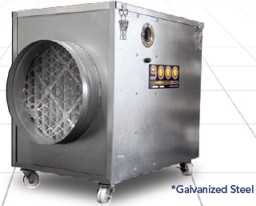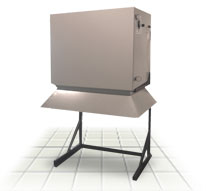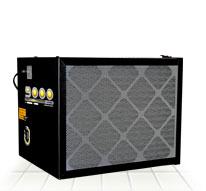A study underway at the University of Alberta (UoA) may shed light on health effects that exposure to welding fumes and metal dust have on female workers in metalworking and electrical trades.
The research project, called "Women's Health in Alberta Trades - Metalworking and Electricians" (WHAT-ME), is a collaboration among researchers from the UoA, Northern Alberta Institute of Technology and the Alberta Apprenticeship and Industry Training.
It targets women in the province who have taken part in apprenticeship training in one of the relevant trades at any time during the last five years.
"It would include a variety of different trades where welding is a significant component," co-investigator Dr Jeremy Beach, associate professor with the UoA, says of the study.
Metalworking jobs include welders, boilermakers, ironworkers and blacksmiths, while electrical trades include cable installers, power line technicians, and construction/marine/plant electricians.
About 180 women recruited to date for study
Approximately 180 women, of which about 10 are pregnant, have been recruited for the study. Apart from reproductive health, the study will also look at health issues surrounding respiratory health, skin problems, nickel sensitization and musculoskeletal problems, Dr Beach says.
The initial motivation came from the Canadian Standards Association (CSA), which has raised concerns about possible health risks to pregnant welders who are exposed to welding fumes, says Dr Beach. "There have been a number of different health hazards but nobody's looked in much detail about women as a group when they come into this trade."
David Hisey, chair of the safety committee on welding, cutting and allied processes for the CSA, says that there is a need for an "increased level of safety" considering more female welders are entering the workforce in Western Canada.
"We want to make sure we know the hazards that we are putting our kids into and if there's more protection that needs to be provided for all workers, then we need to be looking at that," he adds.
Dr Nicola Cherry, the study's lead investigator and head of the occupational medicine program at the UoA, was initially concerned that the numbers of women in these trades were so small "that you just couldn't find out anything useful," says Dr Beach.
More women taking on welding jobs
The last few years have seen an increase in women, prompted by the shortage of tradespersons in the province. "There has been definitely a noticeable increase in females in welding trades for sure," agrees Dan Tadic, director with the Canadian Welding Association in Milton, Ontario.
Welding, a process that uses high heat to melt and join metals, is widely used across various industrial sectors such as construction, shipbuilding and bridge construction. "Just about anything that uses metal can and is usually welded," says Tadic.
There are hazards, however, which can include eye injury (from intense light and flying hot slag), radiation and toxic welding fumes consisting of oxides, silicates and fluorides, notes information from the Canadian Centre for Occupational Health and Safety.
A 2008 study from Finland found that maternal exposure to welding fumes or metal dusts during pregnancy may increase the risk of preterm delivery and reduce intrauterine growth.
There was also some suggestive, but inconsistent, evidence that the risk of preterm delivery and reduced fetal growth is related to paternal exposure to welding fumes, the paper notes.
Results were gleaned from observations of 1,670 women who worked during pregnancy, of which 68 (four per cent) were exposed to either welding fumes or metal dusts or fumes.
The paper found that nitrogen oxide, a compound found in welding fumes and/or metal dusts, was identified as a compound responsible for low birth weight and spontaneous abortion among dental assistants.
"Prenatal exposure to [a] complex mixture of combustion products, emissions from unvented or poorly vented stoves, and ambient air pollution may also increase the risk of adverse pregnancy outcomes," the paper adds.
"It depends on how well you take care of yourself," suggests Gerald Bellehumeur, president of GRB College of Welding in Edmonton, says of welding and its effects on pregnant workers. "[I've seen] women in the trade for so many years. Women work until they are six or seven months pregnant."
Source: OHS Canada
Capture harmful welding fumes at the source

The Fume Extractor captures many
welding fumes at the source.
Electrocorp has designed air filtration systems for welding and soldering applications to protect workers from many chemicals and welding fumes at the workplace.
The portable, powerful units capture many toxic fumes at the source and adsorb gases and chemicals in a deep bed of activated carbon, using 40 to 80 pounds of this efficient filtration media.
The units are designed for TIG, MIG and arc welding operations and feature a spark arrestor, flexible arm and optional custom carbon blends as well as a HEPA filter for particles.
Electrocorp also offers air purifiers specifically designed for soldering applications, including a tabletop unit with an intake hood and a smoke particle filter as well as an activated charcoal filter.
Contact us to find an IAQ solution for you!




















 Tobacco smoke consists of nicotine, tars, water vapor, carbon dioxide, and a substantial number of chemicals and many other irritants. Tars adhere to walls, furniture, carpets, clothing and other articles having large surfaces. After most of the vapor and smoke in the air has been removed by the impregnated carbon media, the walls and other surfaces may retain a film of liquid tar, much of which slowly evaporates back into the air.
Tobacco smoke consists of nicotine, tars, water vapor, carbon dioxide, and a substantial number of chemicals and many other irritants. Tars adhere to walls, furniture, carpets, clothing and other articles having large surfaces. After most of the vapor and smoke in the air has been removed by the impregnated carbon media, the walls and other surfaces may retain a film of liquid tar, much of which slowly evaporates back into the air.  Tobacco smoke poses a unique indoor air quality concern. Not only does tobacco contain chemicals, odors, and smoke particles; those particles contain tar which block up conventional particle filters in air purifiers. An air purifier for tobacco smoke must be able to combat all of these concerns without having the tar quickly ruin the filters.
Tobacco smoke poses a unique indoor air quality concern. Not only does tobacco contain chemicals, odors, and smoke particles; those particles contain tar which block up conventional particle filters in air purifiers. An air purifier for tobacco smoke must be able to combat all of these concerns without having the tar quickly ruin the filters. 








